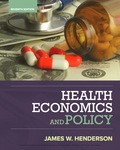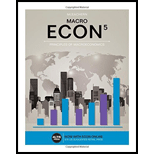The price of salmon is on an upward trend. Demand for the fish is growing as consumers worldwide have a greater appreciation of its health-giving properties. Supply is struggling to keep Worldwide, the price of fish feed is rising as a result of more fish farming and limited catches of anchovies, an important source of fish feed. too can impact on supply. In 1. Using Figure 12, identify two significant features of the data shown. In your answer, back up your comments with data.
The price of salmon is on an upward trend. Demand for the fish is growing as consumers worldwide have a greater appreciation of its health-giving properties. Supply is struggling to keep Worldwide, the price of fish feed is rising as a result of more fish farming and limited catches of anchovies, an important source of fish feed. too can impact on supply. In 1. Using Figure 12, identify two significant features of the data shown. In your answer, back up your comments with data.
Essentials of Economics (MindTap Course List)
8th Edition
ISBN:9781337091992
Author:N. Gregory Mankiw
Publisher:N. Gregory Mankiw
Chapter5: Elastic And Its Application
Section: Chapter Questions
Problem 10PA
Related questions
Question
100%
1. Using Figure 12, identify two significant features of the date shown. In your answer, back up your comments with data.

Transcribed Image Text:Salmon prices on the rise
The price of salmon is on an upward
trend. Demand for the fish is growing
as consumers worldwide have a
greater appreciation of its health-giving
properties. Supply is struggling to keep
up with this trend.
Almost all salmon sold today is farmed
The weather too can impact on supply. In
2013, Norway suffered colder than usual
seawater which inhibited the growth
salmon rather than wild salmon caught of salmon and so the total tonnage of
salmon produced fell.
in the sea or rivers. Rising prices have
led to increased profits for salmon
farmers. Norway Royal Salmon, for
example, reported its highest profits in
its 21-year history in 2013.
However, despite the incentive of
rising profits, there are factors which
are holding back the expansion of
the industry. In Norway, the largest
producer of farmed salmon, production
by private firms is restricted by the
government, which issues licences.
There is also a limit on the number of
salmon which can be farmed in one
place because of the risk of disease.
Figure 12
Salmon prices
60-
50
40
30
Norwegian Krone per kg
20
www
Worldwide, the price of fish feed is rising
as a result of more fish farming and
limited catches of anchovies, an important
source of fish feed.
2013
Source: adopted from the Financial Times
15.3.2014, All Rights Reserved.
Evaluation
Question 3 osks how easily the quantity
supplied of salmon can be changed in
response to changes in its price. In your
answer, write about the short term - if the
price solmon doubled today, for example,
could the quantity supplied of salmon
double in the next year? What are the
constraints on increasing supply? Then
consider the long term. What are the
constraints on increasing supply and how
important are they? Come to an overall
condusion about the short term and
long term.
2012
2014
Source: adapted from Thomson Reuters Dotostream; the Financial Times
15.3.2014, All Rights Reserved.
2.0-
1.5-
1.0-
1. Using Figure 12, identify two
significant features of the data
shown. In your answer, back up your
comments with data.
Figure 13
Total world salmon production
Million tonnes
2.5
2. Using supply curve diagrams,
explain the effects on the supply of
salmon of the following described in
the artide:
(a) a change in profits by fish
farmers;
(b) licences issued by governments
to salmon farmers;
a change in fish feed prices;
2008
(c)
(d) changes in the weather.
3. Discuss whether the price elasticity
of supply of salmon is likely to be
high or low.
10
F
Total world salmon production
09
12
Source: adapted from Food and Agriculture Organization of the United
Notions, GLOBEFISH HIGHLIGHTS, January-Sept 2014, 31.1.2015, Rome, Italy
Reproduced with permission.
11
13
Expert Solution
Step 1
Demand has a functional relationship with the price of the product. As per the law of demand when the price increases then demand should decline and when the price decrease the demand should increase.
Apart from the price of the product if other factors changes then demand also changes simultaneously.
When demand increase due to some factors then it works reverse such as when demand increase then price also increases and when demand decrease then prices also decrease.
Step by step
Solved in 2 steps with 1 images

Knowledge Booster
Learn more about
Need a deep-dive on the concept behind this application? Look no further. Learn more about this topic, economics and related others by exploring similar questions and additional content below.Recommended textbooks for you

Essentials of Economics (MindTap Course List)
Economics
ISBN:
9781337091992
Author:
N. Gregory Mankiw
Publisher:
Cengage Learning



Essentials of Economics (MindTap Course List)
Economics
ISBN:
9781337091992
Author:
N. Gregory Mankiw
Publisher:
Cengage Learning



Principles of Economics 2e
Economics
ISBN:
9781947172364
Author:
Steven A. Greenlaw; David Shapiro
Publisher:
OpenStax

